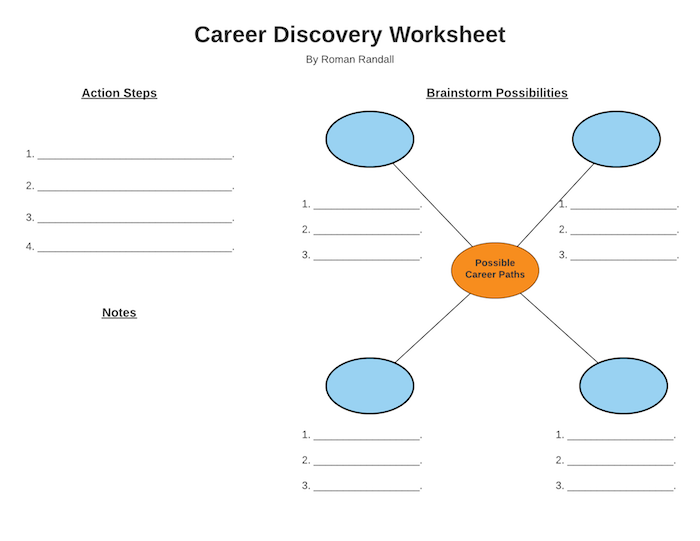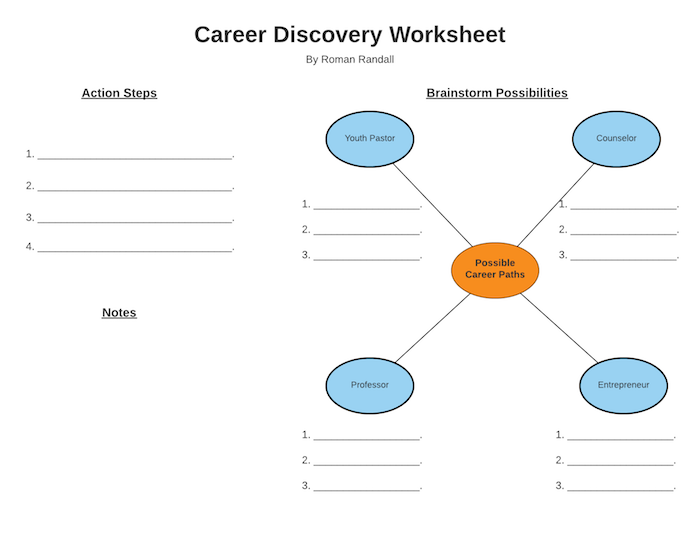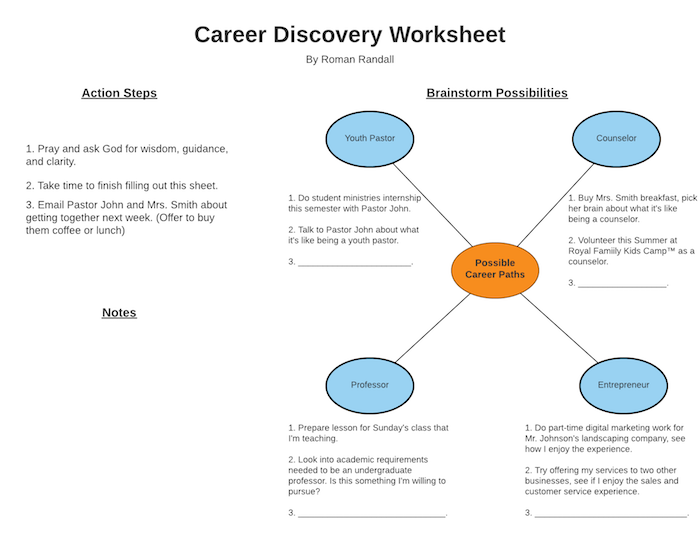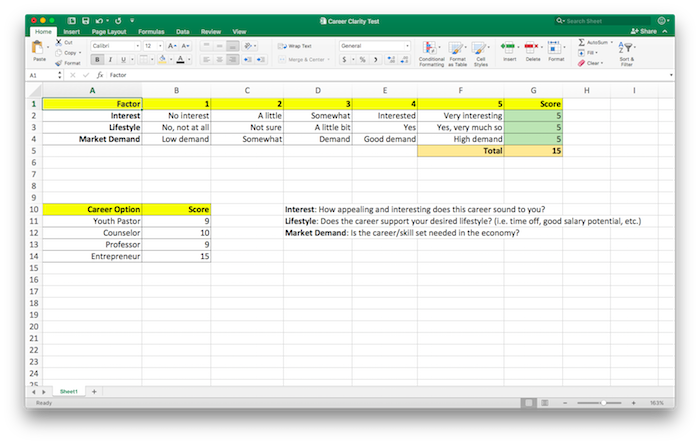I know two people who have very different experiences of work each day.
The first person wakes up each morning, dreads going to work, feels bored and unengaged at their job, and would love to quit. They feel stuck, confused, and don’t know what they should do with their life — but they know what they’re currently doing is not what they want to be doing.
The other person wakes up each morning feeling energized and excited about starting work. This person can’t wait to begin the day, and most days seems to fly by because they are engaged in the work they’re doing.
Which person are you? Which person can you relate to more? Do you enjoy the work you do each day, or do you feel bored and disengaged with your work?
If you currently feel stuck, confused, and don’t know what you should do with your life, keep reading – this post is for you.
The Best Career Advice Comes
From the Bible (Not Kidding)
I once heard a professor say that a “career” is the total work one does in their lifetime. I think that’s a great definition. Your career is not just a job you work for 30+ years – it’s the total work you do throughout your lifetime: Jobs, projects, products, services, art, podcasts, all of it.
I think the best career advice comes from the Bible, from the book of Ecclesiastes:
I perceived that there is nothing better for them than to be joyful and to do good as long as they live; also that everyone should eat and drink and take pleasure in all his toil—this is God’s gift to man.” (Ecclesiastes 3:12-13 ESV)
According to Ecclesiastes 3:12-13, taking pleasure in your toil (doing work you enjoy) is God’s gift to you.
This is great career advice: do work you enjoy.
But how do we figure out what work we enjoy, narrow down our options, and choose a career that is best for us? Here’s a four-step framework I’ve used in my own life, that you can use to gain clarity on what work you should be doing.
- Brainstorm all possibilities
- Test drive and refine
- Score your options
- Avoid the drift
Let’s dive into this simple process together step-by-step.
Step 1: Brainstorm Possibilities
(Leave All Options On The Table)
Have you ever made pasta? If so, you know that one of the first things you need to do is boil the water. And here’s the thing about boiling water: It doesn’t happen instantaneously. It takes time for the water to heat up and come to a boil before you can put the pasta in and cook it.
Similarly, you need to take the time to think through and discuss possible career paths and let new ideas bubble up to the surface. Do a massive mind dump and leave all options on the table. Don’t think any career is out of reach. If something sounds interesting or enjoyable, add it to your list. Try to get at least four solid career options written down on paper. You can prune and eliminate options as you take action (coming up next in step #2).
Here’s a practical exercise for you to do. Click this link and print out the career discovery worksheet. In the blue circles, write down four possible careers that interest you: Doctor, lawyer, computer programmer, professional gardener, whatever. Don’t worry about the lines underneath – we’ll get to that in step #2. (If you have more than four, print off the worksheet again.)

The goal here is to brainstorm all the possible careers you could choose, and get these ideas out of your head and onto paper.
Here are a few ways to begin brainstorming and get the ideas brewing:
- Are there any careers that sound interesting to you? Do you naturally have an interest towards X or Y?
- Have you done any work in the past that you really enjoyed doing?
- Talk with your spouse, family, and close friends who know you well, and ask them what they could see you doing. (Be careful with this — you want to discover and do work you enjoy; you don’t want to be living other peoples’ dreams for your life.)

Step 2: Test Drive and Refine
(Don’t Be Afraid to Pivot)
Recently, my 1999 Toyota Avalon broke down again. Since the car is almost 20 years old and has over 227,000 miles on it, I decided that it couldn’t hurt to start car shopping.
So the other week I went to a car dealership to check out I car I saw online. The car seemed like a sweet deal and the price was good, so I wanted to test drive it to see if it was legit or not. I drove to the dealership, talked to the sales rep, test drove the car, inspected the interior and exterior, and then went home to process the decision with my wife.
When you go car shopping, you get to test drive the car, inspect it, and make sure it’s what you want before you purchase it. In fact, it’s extremely rare (and stupid) to purchase a car without test driving it in real life.

You should do the same thing with your career: take it for a “test drive” and make sure it’s what you want before you decide to go with it. Too many of us “buy a career” before we test drive it. Just like you can test-drive cars, you should also test-drive careers.
When I was in college, I thought I wanted to be a youth pastor. Along with my formal college education, I was also a student ministries intern at a local church for two years. This internship allowed me to “test drive” my future career in a tangible way.
Towards the end of my two-year internship, I began to realize that this career was not the work I wanted to be doing with my life. So, after much prayer, thinking, and discussion with respected family members and friends, I decided to pivot.
I ended up “test driving” another career (mental health counselor) for about a year, before pivoting again and test driving business. While test driving business, I realized that business and entrepreneurship was the work I wanted to be doing full-time.
Had I jumped into being a youth pastor or mental health counselor full-time without test driving these careers first, I may have committed to a career I didn’t truly enjoy. This would have led to frustration and disappointment. There’s nothing wrong with these careers – in fact, my wife is a mental health counselor – but it’s not the type of work I want to be doing.
So, be sure to test drive a career before you commit it. It will save you time, energy, and money in the long run.
How do you “test drive” a career? By taking action. Action brings clarity. Only by doing stuff will you be able to know if this career is for you or not.
There are three ways to take action and gain clarity on your career and calling:
- Do stuff
- Talk to people
- Talk to God
That’s it.
So taking your diagram above (with career possibilities filled in the four bubbles), right down different ways you can take action for each career possibility on the lines underneath. This will be your “test drive” – your action plan for each career – that will help you narrow down your options and come to the best choice for you.

Some things to think about:
- Who do you know that’s doing one of your potential careers? Consider buying them coffee or lunch and asking them a bunch of questions about their work. (Most people will enjoy sharing their career and work experience with you.)
- Do your family and/or friends know anyone in one of these four careers?
- Are there any internship, volunteer, or part-time work opportunities that you could try?
- Could you start a project yourself to test drive one of these options?
- Who could you shadow for a day?
And through all of this, don’t forget the most important part: prayer. Be praying and asking God to guide you, show you how he made you, and to reveal what kind of work you enjoy.
Step 3: Score Your Options Using This Scorecard
I created a simple scorecard that you can use to score and rank your different career options. Run every career possibility that you listed in a bubble above (step #1) through this scorecard. As you give each career possibility a score, add it to the “Career Option: table underneath.
Interest: How appealing and interesting does this career sound to you?
Lifestyle: Does the career support your desired lifestyle? (i.e. time off, good salary potential, etc.)
Market Demand: Is the career/skill set needed in the economy?

You can download it for free in the career clarity resource bundle. This will give you a concrete look at which career path most aligns your interests and desired lifestyle with what the market needs/wants. There is no right answer, but the career with the highest score might be the best choice for you.
Step 4: Avoid the Drift
(Don’t let your mind hold you back)
I remember being at the beach one year with my family – aunts, uncles, cousins, everyone. It was awesome. At one point, my aunt got on one of those pool flotation rafts near the shore and decided to coast out into the water, not really intending on going anywhere specific. Within an hour, my aunt had floated way out into the lake – about two hundred yards away from the shore. I still remember this happening because I was shocked how far she seemed to be.
If you’re not intentional with where you want to go, the same thing can happen in your career – you’ll end up drifting aimlessly, far off in a direction you never intended to go.
This fourth and final step is ultimately about decisions making: at the end of the day, you need to make a choice and decide your career path – no one else can do this for you.
Avoid the Drift. Don’t let internal forces (confusion, fear, lack of ambition) or outside forces (people’s opinion, events, teachers, failures, setbacks, etc.) cause you to drift towards random destinations. Become aware of what’s holding you back and be intentional about learning about yourself, your interests, and your strengths.
What causes people to drift? Most of the time, there are three things: Confusion, fear, and/or lack of ambition.
Bronnie Ware used to work in palliative care, caring for the needs of those who were dying. During the time she spent tending to their needs, she learned some of the most common regrets these people had at the end of their lives. Do you know what the #1 regret of the dying was? It was: “I wish I’d had the courage to live a life true to myself, not the life others expected of me.”
Wow.
Don’t get to the end of your life and have this regret. If you are drifting in your career or life — because of fear, confusion, lack of ambition, or some other reason — recognize it, choose to live courageously, and decide to make a change. Life is too short to be miserable in your work and let fear call the shots. Becoming aware of our own drift – and taking action against it – is the only way to resolve this problem. The pain of not knowing what to do has to frustrate you more than the pain of drifting aimlessly.
Conclusion
Choosing a career is no easy task. It takes time and effort to clarify our strengths, interests, and figure it all out. There will be pivots: times when you learn something new about yourself and have to adjust course. That’s perfectly fine, and should be expected.
In summary, here are the four action steps to help you choose a career you enjoy:
- Brainstorm all possibilities: When figuring out what career path is best for you, the very first step is to brainstorm all the career possibilities that sound interesting to you. Leave all the options on the table, and write them down on paper.
- Test drive and refine: Just like you test drive a car before you buy it, you should test drive different careers before you commit to one. For each career possibility you’re considering, take 2-3 action steps to gain clarity on whether or not you’d enjoy that career.
- Score your options: Use the career clarity scorecard to score your career options and see which one aligns your interests and desired lifestyle with the needs of the economy.
- Avoid the drift: Don’t let fear, lack of ambition, people’s opinions, confusion, or anything else cause you to drift in your career and life.
Remember this: doing work you enjoy is a gift from God. Discovering work you enjoy is something you should pray for and seek until you discover it.
Nice post. I learn something totally new and challenging on websites I stumbleupon every day.
It’s always useful to read articles from other writers and practice something
from their sites.